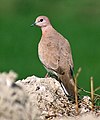Laughing dove
| Laughing Dove | |
|---|---|

| |
| Scientific classification | |
| Kingdom: | |
| Phylum: | |
| Class: | |
| Order: | |
| Family: | |
| Genus: | |
| Species: | S. senegalensis
|
| Binomial name | |
| Streptopelia senegalensis Linnaeus, 1766
| |


The Laughing Dove (Streptopelia senegalensis) is a small pigeon which is a resident breeding bird in the tropics in Africa south of the Sahara, the Middle East and southern Asia east to India. In India it is also known as the Little Brown Dove. Probably as the result of stowaways from Africa or India, the bird is also found in a localised area of Western Australia - in and around Perth and Fremantle.
It is a common and widespread species in scrub, dry farmland and habitation over a good deal of its range, often becoming very tame.
This species builds a stick nest in a tree and lays two white eggs. Its flight is quick, with the regular beats and an occasional sharp flick of the wings which are characteristic of pigeons in general.
Laughing Dove is a long-tailed, slim pigeon, typically 25 centimetres (10 inches) in length. Its back, wings and tail are reddish-brown with blue-grey in the wings. In flight, the underwings are rich chestnut.
The head and underparts are pinkish, shading to whitish on the lower abdomen. There is black spotting on the throat. The legs are red. The chuckling call is a low oo-took-took-oo-roo, with the emphasis on the took-took. Sexes are similar, but juveniles are more rufous than adults, and have reduced throat spotting.

Laughing Doves eat grass, seeds, grains, other vegetation and small insects. They are fairly terrestrial, foraging on the ground in grasslands and cultivation. They are not particularly gregarious, and are usually alone, or in pairs.
This species has recently been placed into the genus Stigmatopelia by some authorities following the studies of Johnson et al. (2001).
References
- Barlow: Birds of The Gambia. Wacher and Disley, ISBN 1-873403-32-1
- Grimmett: Birds of India. Inskipp and Inskipp, ISBN 0-691-04910-6
- Johnson, Kevin P.; de Kort, Selvino; Dinwoodey, Karen, Mateman, A. C.; ten Cate, Carel; Lessells, C. M. & Clayton, Dale H. (2001): A molecular phylogeny of the dove genera Streptopelia and Columba. Auk 118(4): 874-887. PDF fulltext





